The 1975 Fiat X1/9, a sleek and sporty mid-engine coupe, burst onto the automotive scene in a time of significant change. The 1970s marked a transition in car design, with a growing emphasis on fuel efficiency and safety, yet the X1/9 remained true to its Italian heritage, offering a blend of performance and style that captured the hearts of enthusiasts.
This article delves into the history, design, and legacy of this iconic car, exploring its unique features, driving experience, and enduring cultural impact.
Born from a collaboration between Fiat and Bertone, the X1/9 was a testament to the Italian design prowess of the era. Its low-slung profile, sculpted lines, and distinctive pop-up headlights made it instantly recognizable. Underneath its fiberglass bodywork lay a revolutionary mid-engine layout, a design philosophy that was still relatively uncommon at the time.
This engineering choice significantly enhanced the car’s handling and agility, making it a true driver’s car.
Introduction: 1975 Fiat X1/9
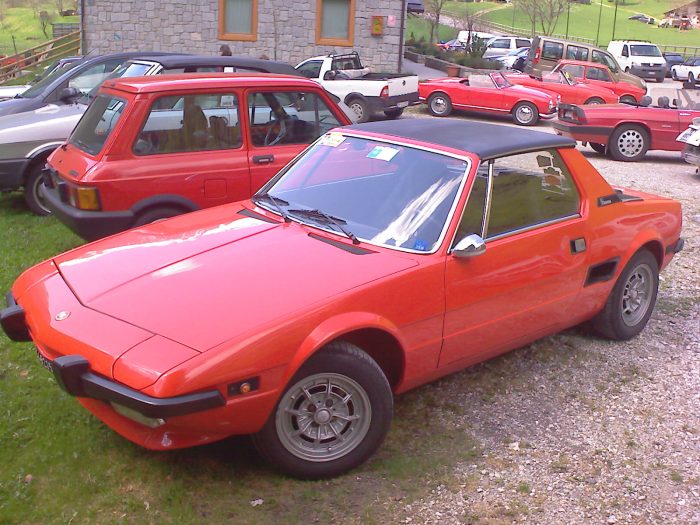
The Fiat X1/9, a sporty two-seater mid-engined coupe, marked a significant chapter in the history of Fiat and the automotive landscape of the 1970s. This iconic Italian design, conceived by renowned coachbuilder Bertone, captured the spirit of the era with its sleek, wedge-shaped profile and agile handling.
The X1/9’s release in 1975 coincided with a surge in popularity for small, fuel-efficient cars, driven by the energy crisis and a shift towards more practical and affordable vehicles.
The Automotive Landscape of the 1970s
The 1970s marked a turning point in the automotive industry, characterized by significant economic and social changes. The energy crisis, triggered by the 1973 oil embargo, prompted a global demand for fuel-efficient cars. This shift in consumer preferences led to the rise of compact and subcompact models, often featuring smaller engines and lighter designs.
The X1/9, with its diminutive size and relatively low fuel consumption, perfectly aligned with this evolving automotive landscape.
Design and Engineering
The Fiat X1/9, a small, two-seater sports car, was a unique and innovative design that combined sporty performance with a stylish and practical package. Its mid-engine layout, distinctive design elements, and fiberglass body construction contributed significantly to its appeal and performance.
Mid-Engine Layout, 1975 Fiat X1/9
The X1/9’s mid-engine layout, a configuration where the engine is placed behind the passenger compartment and ahead of the rear axle, was a defining characteristic. This arrangement offered several advantages in terms of handling and performance:
- Improved Weight Distribution:Placing the engine centrally helped achieve near-perfect weight distribution, enhancing the car’s balance and stability, particularly during cornering.
- Enhanced Handling:The mid-engine layout lowered the car’s center of gravity, resulting in better handling and a more responsive steering feel. The weight distribution also reduced understeer, a common problem in front-engine cars, allowing for more precise and enjoyable driving experiences.
- Improved Traction:The weight of the engine over the rear wheels provided superior traction, particularly during acceleration. This allowed for quicker launches and better overall performance.
Design Elements
The X1/9’s design was a blend of sporty and practical elements. The wedge-shaped body, with its sloping nose and prominent rear spoiler, was a testament to the car’s performance-oriented nature.
- Low-slung Profile:The X1/9’s low-slung profile, achieved through its mid-engine layout and aerodynamically designed bodywork, contributed to its sleek and sporty appearance. It also improved the car’s stability at high speeds.
- Pop-up Headlights:The X1/9’s pop-up headlights were a distinctive feature that added to its aggressive and futuristic appearance. They were also a practical solution, as they allowed for a lower hood line and improved aerodynamics.
- Targa Roof:The optional targa roof, which could be removed to provide an open-air driving experience, added to the X1/9’s versatility and appeal. It allowed drivers to enjoy the sun and fresh air while still maintaining a level of safety and security.
Fiberglass Body Construction
The X1/9’s body was made of fiberglass, a lightweight and durable material that offered several advantages:
- Reduced Weight:Fiberglass is significantly lighter than steel, contributing to the X1/9’s overall lightness and improved performance. The lighter weight also improved fuel efficiency.
- Enhanced Design Flexibility:Fiberglass offered greater design flexibility compared to steel, allowing for more complex and aerodynamic shapes. This enabled the X1/9’s distinctive wedge-shaped design.
- Cost-Effectiveness:Fiberglass was a more cost-effective material for producing the X1/9’s body compared to steel, making the car more affordable for its target market.
Fiberglass construction also had some disadvantages:
- Durability Concerns:Fiberglass, while durable, was susceptible to cracking and damage, especially in the event of a collision. This made repairs more challenging and expensive than with steel bodies.
- Heat Sensitivity:Fiberglass can be prone to warping and deformation under extreme heat, particularly in hot climates.
Powertrain and Performance
The Fiat X1/9 was designed as a lightweight and nimble sports car, and its powertrain options reflected this focus. While not the most powerful car of its era, the X1/9 offered a satisfying driving experience, particularly for enthusiasts seeking a balance between performance and affordability.
Engine Options
The X1/9 was offered with a variety of engine options over its production run, each providing a unique driving character.
- 1.3-liter 4-cylinder engine (1972-1978):This was the base engine for the early X1/9 models, producing 75 horsepower and 80 lb-ft of torque. While not exceptionally powerful, it provided adequate performance for everyday driving and a relatively engaging driving experience.
- 1.5-liter 4-cylinder engine (1979-1981):This engine, with a larger displacement, offered increased power and torque, producing 85 horsepower and 93 lb-ft of torque. It provided a noticeable improvement in acceleration and overall performance, making the X1/9 more competitive with other sports cars of the time.
- 1.6-liter 4-cylinder engine (1982-1989):The final engine option for the X1/9, this engine was the most powerful, producing 90 horsepower and 96 lb-ft of torque. This engine provided a more spirited driving experience, making the X1/9 a capable performer on winding roads.
Transmission Choices
The Fiat X1/9 was available with a choice of two transmissions: a 5-speed manual and a 4-speed automatic. The manual transmission was the more popular option, offering greater driver control and a more engaging driving experience. The automatic transmission, while less common, provided a more relaxed driving experience, particularly in urban environments.
- 5-speed manual:This was the standard transmission for the X1/9 and provided a precise and engaging shift feel. It allowed for optimal gear selection, maximizing the engine’s power and efficiency.
- 4-speed automatic:The automatic transmission, while less common, provided a more relaxed driving experience, particularly in urban environments. It offered smooth and effortless gear changes, but sacrificed some of the driver engagement offered by the manual transmission.
Performance Figures
The X1/9’s performance figures varied depending on the engine and transmission chosen. However, all models were known for their lightweight construction and nimble handling, making them fun to drive on winding roads.
The 1975 Fiat X1/9, a stylish and sporty mid-engined coupe, was a popular choice for those seeking a fun and affordable driving experience. While the X1/9 was known for its nimble handling and engaging performance, Fiat also offered a more practical option in the form of the 1981 Fiat 131 , a rally-bred sedan with a more spacious interior and a focus on comfort.
The X1/9, however, remained a unique and desirable car for its sleek design and driving dynamics, appealing to a different segment of the market.
| Engine | Transmission | 0-60 mph | Top Speed |
|---|---|---|---|
| 1.3-liter | 5-speed manual | 11.5 seconds | 98 mph |
| 1.5-liter | 5-speed manual | 10.5 seconds | 105 mph |
| 1.6-liter | 5-speed manual | 9.5 seconds | 110 mph |
Driving Experience
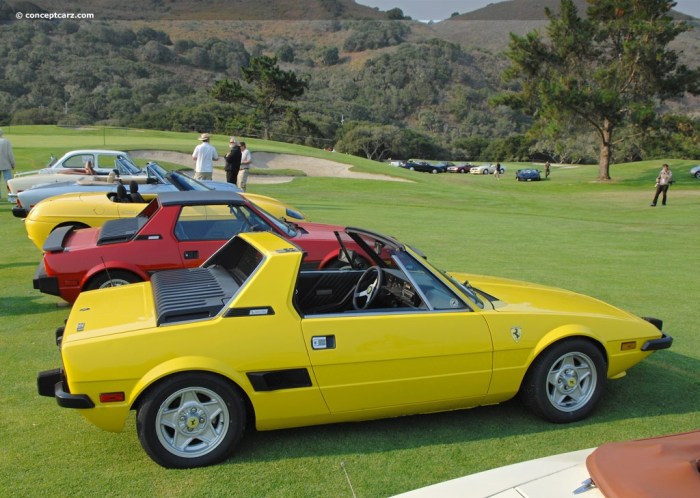
The Fiat X1/9, with its lightweight construction and mid-engine layout, offered a unique and engaging driving experience. Its handling, steering, and braking characteristics combined to deliver a car that was both fun and capable.
Handling and Steering
The X1/9’s handling was praised for its agility and responsiveness. The car’s low center of gravity, independent suspension, and relatively narrow track width contributed to its nimble nature. The steering was precise and provided good feedback, allowing drivers to feel the road surface and react accordingly.
However, the car’s lack of power steering could be tiring on long drives, especially in urban environments.
Braking
The X1/9’s braking system, while effective, could be somewhat lacking in stopping power, particularly in later models. The front disc brakes provided adequate performance, but the rear drum brakes were prone to fading under heavy braking. This was particularly noticeable when driving on twisty roads or during spirited driving.
Overall Driving Experience
The Fiat X1/9 was a car that was most enjoyable when driven on winding roads. Its agile handling and responsive steering made it a delight to drive through corners. The car’s lightweight construction and relatively low power output meant that it was not particularly quick in a straight line, but its handling made up for it.
The X1/9 was also comfortable enough for daily driving, although its lack of power steering could be a drawback in urban environments.
Suitability for Different Driving Scenarios
City Driving
The X1/9’s small size and nimble handling made it relatively easy to maneuver in city traffic. However, its lack of power steering could make it tiring to drive in stop-and-go traffic. The car’s small engine and relatively low power output also meant that it could be underpowered in urban environments.
Highway Cruising
The X1/9 was not particularly well-suited for highway cruising. Its small engine and relatively low power output meant that it was not particularly quick in a straight line, and the lack of power steering could be tiring on long drives.
The 1975 Fiat X1/9, a sporty mid-engine coupe, was a popular choice for enthusiasts seeking a fun and affordable driving experience. Its design, a collaboration between Bertone and Fiat, was inspired by the earlier Fiat 850, a compact city car that was known for its agility and fuel efficiency.
You can learn more about the 1972 Fiat 850 and its influence on the X1/9 by exploring its history online. While the X1/9 was larger and more powerful, it retained the same spirit of driving enjoyment that made the 850 a beloved classic.
The car’s suspension was also on the firm side, which could make it uncomfortable on long stretches of highway.
Spirited Driving
The X1/9 was most at home on winding roads, where its agile handling and responsive steering could be fully appreciated. The car’s lightweight construction and relatively low power output meant that it was not particularly quick in a straight line, but its handling made up for it.
The X1/9 was a true driver’s car, rewarding those who were willing to push it to its limits.
Cultural Impact and Legacy
The Fiat X1/9, with its unique design and sporty performance, left a lasting mark on automotive culture. Beyond its practical purpose as a vehicle, the X1/9 became a symbol of the 1970s, appearing in popular media and influencing the designs of subsequent cars.
The 1975 Fiat X1/9, a sporty mid-engine coupe, showcased Fiat’s design prowess, much like the iconic 1959 Fiat 600 did in its time. While the 600 was a small, affordable city car, the X1/9 aimed for a different segment, offering a blend of Italian flair and driving excitement.
The X1/9, with its lightweight construction and peppy engine, proved to be a popular choice for enthusiasts seeking a fun and affordable sports car.
Pop Culture Appearances
The X1/9’s distinctive shape and affordability made it a popular choice for filmmakers and television producers. Its appearance in films like “The Cannonball Run” (1981) and “The Blues Brothers” (1980) cemented its place in cinematic history. The car’s popularity extended to television shows like “Knight Rider” (1982-1986), where a modified X1/9 was featured as a supporting character.
- The X1/9’s iconic design and its association with the era’s pop culture made it a sought-after prop for filmmakers and television producers. Its appearance in these productions helped to solidify its image as a cool and sporty car.
- In “The Cannonball Run,” the X1/9 was driven by the character played by Sammy Davis Jr., highlighting its sporty nature and ability to keep up with more powerful cars.
- The X1/9’s appearance in “The Blues Brothers” added to its association with the rebellious and fun-loving spirit of the 1970s.
- The X1/9’s role in “Knight Rider” as a modified “KITT” car further cemented its place in popular culture, demonstrating its versatility and potential for customization.
Design Influence
The X1/9’s innovative mid-engine layout and wedge-shaped design influenced the design of subsequent sports cars. Its impact can be seen in cars like the Honda CRX (1983), the Mazda MX-5 Miata (1989), and the Toyota MR2 (1984), all of which adopted similar mid-engine layouts and sporty aesthetics.
- The X1/9’s success demonstrated the viability of a mid-engine layout for affordable sports cars, paving the way for other manufacturers to adopt similar designs.
- The X1/9’s distinctive wedge shape, with its low profile and sloping lines, became a trend in sports car design, influencing the aesthetic of subsequent models.
- The X1/9’s popularity among enthusiasts and its influence on the design of later sports cars helped to establish it as a pioneer in the affordable sports car segment.
Owner Experiences
The X1/9’s loyal following of owners and enthusiasts continues to grow, with many sharing their experiences and stories online and at car shows. These owners appreciate the car’s unique design, handling, and affordability. They often describe the X1/9 as a fun and engaging car to drive, with a strong sense of community among its owners.
- Owners often describe the X1/9 as a car that “puts a smile on your face” due to its responsive handling and engaging driving experience.
- The X1/9’s affordability and ease of maintenance make it a popular choice for enthusiasts who want to enjoy the thrill of a sports car without breaking the bank.
- The X1/9’s active online community provides a platform for owners to share information, tips, and stories, fostering a strong sense of camaraderie.
Notable Features and Options
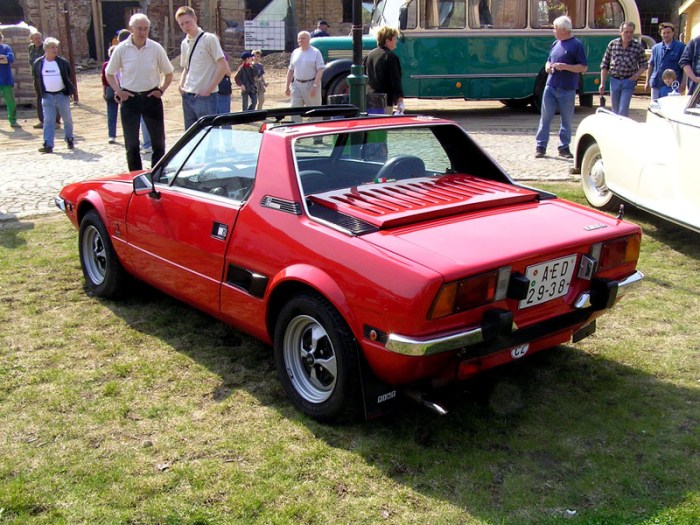
The Fiat X1/9, being a sporty and affordable roadster, offered a range of features and options that catered to different preferences and budgets. These features, available across different model years, enhanced the car’s driving experience and contributed to its unique appeal.
Available Features and Options
The following table provides an overview of the key features and options available for the Fiat X1/9 across different model years:
| Year | Engine | Transmission | Interior Features | Exterior Features | Optional Equipment |
|---|---|---|---|---|---|
| 1973-1978 | 1.3L 4-cylinder | 5-speed manual | Vinyl upholstery, basic dashboard, two-spoke steering wheel | Pop-up headlights, black bumpers, steel wheels | Air conditioning, radio, rear window defroster, tinted windows, hardtop |
| 1979-1981 | 1.5L 4-cylinder | 5-speed manual | Cloth upholstery, updated dashboard, three-spoke steering wheel | Pop-up headlights, color-coded bumpers, alloy wheels | Air conditioning, radio, rear window defroster, tinted windows, hardtop, power steering |
| 1982-1988 | 1.5L 4-cylinder | 5-speed manual | Cloth upholstery, updated dashboard, three-spoke steering wheel | Pop-up headlights, color-coded bumpers, alloy wheels | Air conditioning, radio, rear window defroster, tinted windows, hardtop, power steering, electric windows |
Comparisons and Alternatives
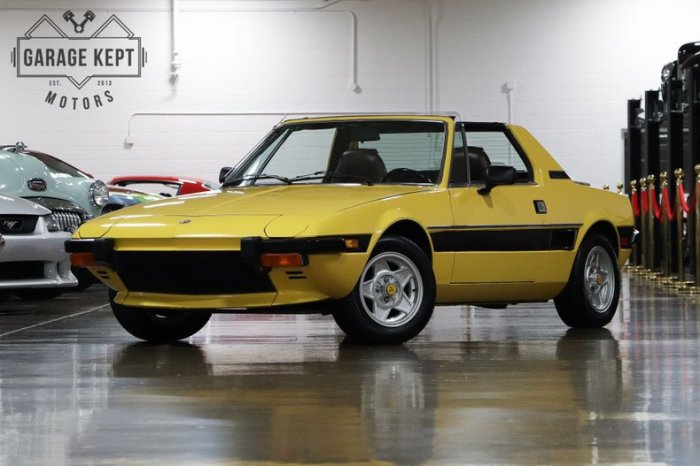
The Fiat X1/9, with its unique design and sporty handling, carved a niche for itself in the sports car market of the 1970s. However, it also faced stiff competition from other European and Japanese manufacturers. Comparing the X1/9 to its contemporaries reveals its strengths and weaknesses, and provides insights into its place within the automotive landscape of the time.
Comparison with Contemporaries
The Fiat X1/9 was positioned against a diverse range of sports cars during its production run.
- British Sports Cars:The MG B and Triumph Spitfire were popular choices, offering open-top driving and relatively affordable pricing. The X1/9’s mid-engined layout provided superior handling, but its lack of a convertible option could be a drawback for some buyers.
- German Sports Cars:The Porsche 914 and 924, while more expensive, offered a more sophisticated driving experience and greater performance. The X1/9, however, was lighter and more agile, making it more fun to drive on winding roads.
- Japanese Sports Cars:The Datsun 240Z and Mazda RX-7 gained popularity for their reliability and affordability. The X1/9, despite its Italian flair, could not match the Japanese cars’ reputation for durability.
Alternative Sports Cars
Buyers seeking a similar driving experience or features to the Fiat X1/9 had a range of options available.
- Lotus Elan:This British sports car, known for its lightweight construction and exceptional handling, provided a similar driving experience to the X1/9, albeit at a higher price point.
- Alfa Romeo Spider:The Alfa Romeo Spider, with its Italian styling and spirited performance, offered a more traditional roadster experience compared to the X1/9’s mid-engined layout.
- BMW 2002:This German compact coupe offered a more practical and refined experience than the X1/9, with its larger interior and more powerful engine options.
Collecting and Restoration
The Fiat X1/9, a sporty and stylish wedge-shaped coupe, has garnered a dedicated following among enthusiasts and collectors. Its unique design, lightweight construction, and engaging driving experience have contributed to its enduring appeal. Today, the X1/9 is considered a classic car, and its value continues to appreciate, making it an attractive investment for collectors.
Market Value and Desirability
The market value of a Fiat X1/9 varies significantly depending on its condition, year of manufacture, and overall desirability. Well-maintained and original examples, particularly those with low mileage, are highly sought after and command premium prices. The most desirable models include the early production cars with the 1.3-liter engine and the later models with the 1.5-liter engine.
Restoring a Classic X1/9
Restoring a classic X1/9 can be a rewarding experience, but it also presents unique challenges. Finding parts can be difficult, as many components are no longer in production. However, a dedicated community of enthusiasts and specialist suppliers offer a wide range of restoration parts and services.
The cost of restoration can vary significantly depending on the scope of the project and the quality of parts used.
Buying a Fiat X1/9
Before purchasing a Fiat X1/9, potential buyers should consider the following factors:
- Condition:Inspect the car thoroughly for rust, damage, and wear and tear. A comprehensive pre-purchase inspection by a qualified mechanic is highly recommended.
- History:Obtain the car’s service history and documentation to verify its authenticity and maintenance records. A well-documented car with a consistent service history is generally more desirable.
- Engine and Transmission:Assess the condition of the engine and transmission. Listen for any unusual noises or leaks. A test drive is essential to evaluate the car’s overall performance.
- Bodywork:Inspect the bodywork for rust, dents, and scratches. Check the alignment of the doors, hood, and trunk. A well-maintained body is crucial for preserving the car’s value.
- Interior:Examine the interior for wear and tear on the seats, carpets, and dashboard. Check the functionality of all the gauges and controls. A clean and well-maintained interior adds to the car’s overall appeal.
Last Word
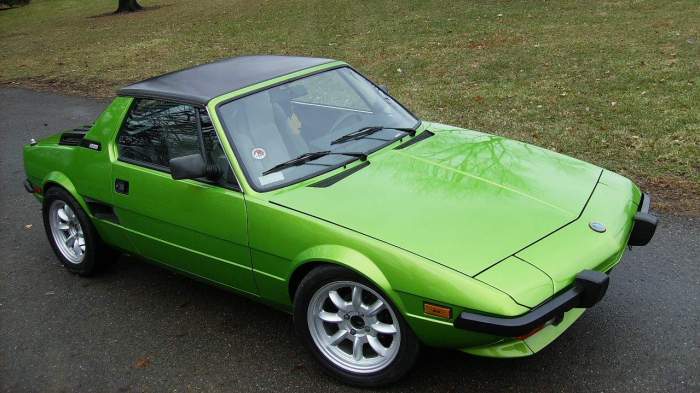
The 1975 Fiat X1/9, despite its relatively short production run, left an indelible mark on the automotive landscape. Its unique design, engaging driving experience, and cultural significance have cemented its status as a true classic. Today, the X1/9 continues to be cherished by enthusiasts worldwide, who appreciate its blend of Italian flair, sporty performance, and timeless appeal.
Whether cruising down a scenic road or participating in a vintage car rally, the X1/9 remains a testament to the enduring allure of classic Italian sports cars.